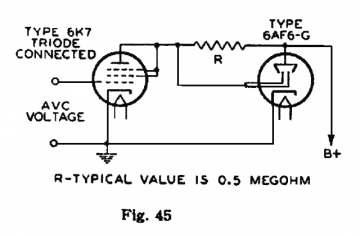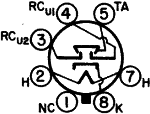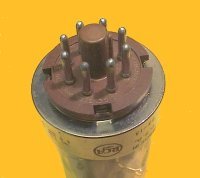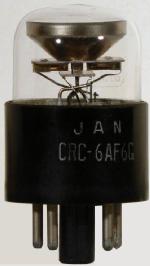
6AF6G
|
|
|||||||||||||||||||||||||||||||||||||||||
|
Hits: 3907 Replies: 0
Optimale Ausnutzung der 6AF6G
|
|
|
Jacob Roschy
17.Sep.11 |
1
Optimale Ausnutzung der 6AF6G Um bei Magischen Augen einen möglichst großen Signalbereich optisch gut darstellen zu können, wurden Röhren mit zwei Anzeigebereichen geschaffen, teilweise mit 2 Leuchtwinkeln (EM4, EM34) oder mit 4 Leuchtwinkeln (EM11, EM35, frühere 6AF7). Die beiden Anzeigebereiche haben eine unterschiedliche Empfindlichkeit, so dass das der eine Bereich schon bei einer eher kleinen Spannung, entsprechend Empfangssignalen mittlerer Stärke, schon Vollausschlag erreicht, während der zweite Bereich erst bei sehr starken Signalen Vollausschlag erreicht. Als Nachteile dieser Anzeigeröhren wäre anzumerken:
Das ideale Zweibereichs- Magische Auge, bei dem der Leuchtschirm voll zur Anzeige ausgenutzt wird, müsste folgende Eigenschaften haben:
Diese 6AF6G hat zwei Schattenwinkel ähnlich der Röhren EM4 und EM34, besitzt aber kein eingebautes Verstärkersystem. Daher ist zwar immer eine weitere Röhre zur Ansteuerung erforderlich, aber man hat dadurch die völlige schaltungstechnische Freiheit. So kann man der 6AF6G Eigenschaften anzüchten, die mit anderen Magischen Augen nicht möglich sind. Der Schattenwinkel von EM4 und EM34 ist maximal 90°, weil die positive Spannung der Steuerstege auch ohne Steuerspannung immer noch relativ hoch gegenüber der Katode des Leuchtsystems ist. Bei der 6AF6G lässt sich dieses Problem lösen, indem man deren Katode auf eine höhere Spannung gegenüber Masse (GND) anhebt, z. B. auf 75 V mittels einer Stabi- Röhre 0A3 oder 75C1. Mit einer geeigneten Doppeltriode als Steuerröhre, z. B. eine 6C8G, ist es nun möglich, die Steuerstege stark negativ gegenüber der Katode zu steuern, wodurch beide Schattenwinkel sehr groß werden und nur noch ein schmaler leuchtender Streifen übrig bleibt. Der steuerbare, d. h. bewegliche Anteil des Leuchtschirms wird somit erheblich vergrößert.
Solange über das Poti P2 weniger Strom als über R3 fließt, bleibt die Spannung an diesem Gitter G II auf 0 V wegen dessen Diodenwirkung, obwohl sich die negative Steuerspannung erhöht. Erst ab dem Punkt, wo der Strom über P2 den Strom durch R3 erreicht, beginnt die Spannung negativ zu werden. Die Spannung am zweiten Steuergitter G II wird also erst dann negativ, wenn die negative Spannung am ersten Steuergitter G I schon einen bestimmten Betrag überschritten hat. Stellt man P2 so ein, dass die die negative Spannung am zweiten Steuergitter erst dann einsetzt, wenn das erste System der 6AF6G Vollausschlag erreicht hat, so erhält man einen fließenden Übergang von Leuchtwinkel 1 zu Leuchtwinkel 2 . Die gesamte Steuerspannung wird also nacheinander auf beide Leuchtwinkel verteilt.Die beiden Widerstände R5 und R6 bilden mit R1 und R2 jeweils Spannungsteiler, womit das Überlappen der Leuchtfelder verhindert wird. In der Testschaltung betrug die Betriebsspannung +U-b = 272 V, die Spannung an der Katode der 6AF6G, U-k = 72 V, Leuchtschirmspannung U-l gegen Katode = 187 V. Der Spannungshub der 6C8G- Anoden verlief von 30...202 V (A I) , bzw. 17...202 V(A II). Doppeltrioden mit µ = 30...40 und Innenwiderstand 20...30 kΩ, wie hier die 6C8G, sind als Steuerröhren besonders geeignet, so auch die 12AY7. Auch Doppeltrioden, die für Computer- Flip-Flop Schaltungen vorgesehen waren, sind vielversprechend, z. B. 1684, 2033, 6211, E90CC, usw. Diese Röhren benötigen einerseits eine relativ geringe Steuerspannung für Vollausschlag und ziehen andererseits bei U-in = 0V die Anodenspannung tief genug herunter, so dass die Leuchtfelder der 6AF6G sehr schmal werden. Röhren mit niederem µ, wie ECC82, 12AU7, 6AH7, ziehen die Anodenspannung noch weiter herunter ohne wesentlichen Nutzen, sie benötigen aber eine sehr hohe Steuerspannung zur Vollaussteuerung. Röhren mit hohem µ, wie ECC83, 12AX7, 6SL7, benötigen zwar nur wenig Steuerspannung zur Vollaussteuerung, dafür ziehen sie die Anodenspannung nicht weit genug herunter bei U-in = 0V, so dass die Leuchtfelder nicht schmal genug werden.
Das Bild zeigt den Verlauf der beiden Sektoren der 6AF6G, angesteuert von einer 6C8G, während der Zuführung einer Steuerspannung U-in von 0...-15 V. Man erkennt, dass in den beiden oberen Reihen nur eine Änderung im linken Sektor erfolgt, während in den beiden unteren Reihen sich nur noch der rechte Sektor ändert und der linken Sektor auf Vollausschlag verbleibt. Im Anhang befinden sich 16 Einzelbilder des Anzeigeverlaufs. Bei entsprechend schnellem Durchscrollen lässt sich die Bewegung der Anzeige simulieren. Unser Kollege Otmar Jung hatte die geniale Idee, ein animiertes Bild aus der Fotoserie anzufertigen, wofür Ihm herzlich gedankt sei. Wegen der begrenzten Dateigröße ist es leider etwas grießig geworden.
M. f. G. J. R. Attachments |
|
Hits: 12384 Replies: 2
The optimal use of the 6AF6G
|
|
|
Jacob Roschy
20.Oct.11 |
1
An ideal dual-range magic eye, in which the luminescent screen is completely used for the display, would have to have the following properties :
Actually there is no tube available with these properties, but with some effort, one can come relatively close to these demands by using the 6AF6G eye tube.
A positive current bias is applied via a 100 MΩ resistor to the G II grid the of 6C8's second triode unit, while this G II grid is also connected to the control voltage U'in via a 5 MΩ trimpot. The G I grid of the first triode unit is directly connected to the control voltage U-in.
That way the entire range of control voltage is distributed successively to both indicating sections. Low-µ tubes such as ECC82, 12AU7 or 6AH7, pulling down the plate voltage even further without any substantial benefit, but they require a rather high control voltage for full output. If less control voltage is available, high-µ tubes such as ECC83, 12AX7 or 6SL7 may solve the problem. Since their internal resistant is also higher, the plate pull-up resistors R1 and R2 must be changed to 1 MΩ, the pull-down resistors R5 and R6 have to be removed. This way, a 6SL7 requires a control voltage of –7.5 V for full output of both 6AF6 sections, respectively -3.75 V for full output of the first section.
The image shows the course of the two sectors of the 6AF6, driven by a 6C8 as shown in the test circuit, while the control voltage U-in rises from 0 to -15 V.
Our fellow RM member Otmar Jung was so kind to make an animated image from the photo series, which is gratefully acknowledged to him. Best Regards, Jacob
|
|
Michael Watterson
20.Oct.11 |
2
I presume the 6AD6, 6AF6 and 1629 are similar to 6AF6G and only vary in voltage or package? Very interesting article. I had mentioned the dual control of 6AF6 here but with no example of how to use it. I've linked the paragraph to your article now. |
|
Jacob Roschy
24.Oct.11 |
3
Hello Michael, the 6AD6 is indeed similar to the 6AF6(-G), but has a maximum target voltage of 150 V, while the 1629 is merely a 12.6 volt heater octal based version of the 6E5 with built-in driver triode and only one shadow angle, hence dissimilar to the 6AF6. Thank you for setting a link to my article. Best Regards, Jacob |
End of forum contributions about this tube
| Data Compliance | More Information |








